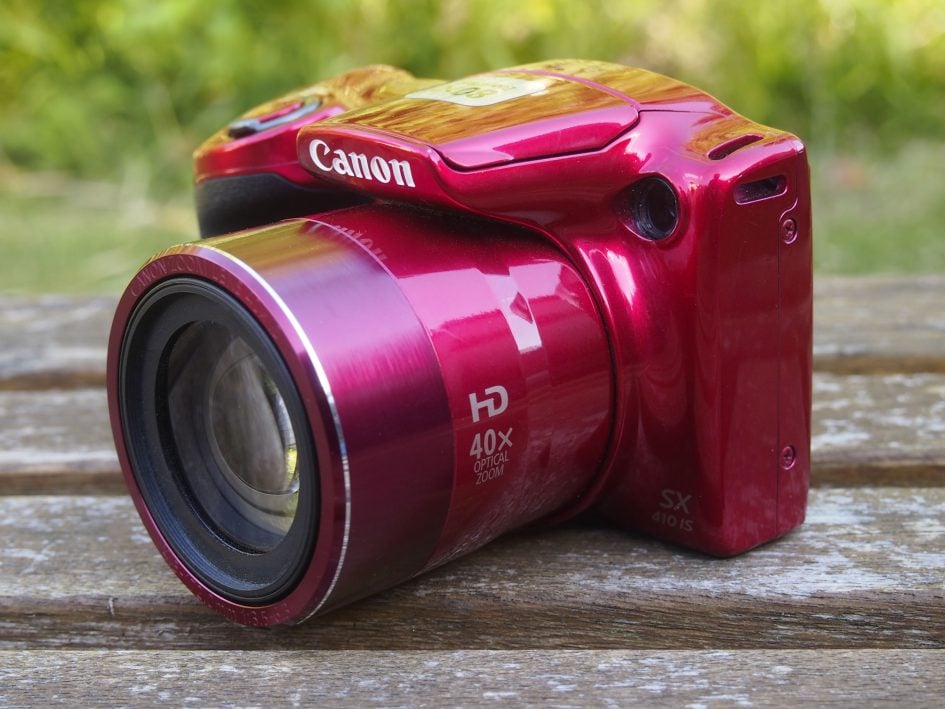Canon PowerShot SX410 IS review
-
-
Written by Ken McMahon
Verdict
The Canon PowerShot SX410 IS is an update to the SX400 IS introduced a little less than a year previously. Canon has extended the zoom range from 30x to 40x and boosted the resolution of the CCD sensor from 16 to 20 Megapixels.
The first of these updates is unquestionably an improvement; it’s clearly better to be able to zoom in closer to your subject in a camera like this and a zoom range that extends to 960mm, compared with 720mm previously, brings all kinds of subjects, particularly wildlife and sports, that much closer.
The increase to 20 Megapixels isn’t such a clear cut improvement, if an improvement at all. Canon has stuck with 16 Megapixels for the higher end SX530 HS and, though it’s upped the megapixel count from 16 to 20 on compact super-zooms like the SX610 HS and SX710 HS, these models employ lower-noise CMOS sensors. In contrast, the CCD sensor in the SX410 IS is visibly noisier throughout the sensitivity range than the two models I compared it with, the SX530 HS and Nikon COOLPIX L840, both of which use 16 Megapixel CMOS sensors.
The payback for these higher resolution, but noisier images is that you can make bigger (although still noisy) prints. Though to be fair if you downsampled the SX410 IS shots to the size of the 16 Megapixel competition the noise artefacts would be less noticeable, but at best that just gets you back to where you started. However you look at it, it’s hard to see much of an advantage from the increase in resolution.

There’s little else that’s new, unless you count a small reduction in continuous shooting speed and battery life. Ultimately, the major benefit of the PowerShot SX410 IS over its predecessor is a longer lens.
As I said in my introduction though, this isn’t to be underestimated, all other things being equal, extra reach at the telephoto end of the zoom range is always welcome, however, there are the alternatives to be considered. One of the most attractive things about the PowerShot SX410 IS, and something that I haven’t yet mentioned is its price: it’s one of the least expensive bridge super-zooms around, but it’s not the only one. The Nikon COOLPIX L840 closely matches it on price and has more to offer in almost every respect.
At 38x, the COOLPIX L840’s optical zoom range is slightly shorter than the PowerShot SX400 IS’s 40x. But look beyond that and it has a wealth of advantages over the Canon model. To begin with, although the COOLPIX L840 falls short of the the PowerShot SX410 IS’s maximum zoom by what looks like a significant figure – 855mm compared with 960mm, in practice the difference isn’t as large as those numbers suggest. Plus the COOLPIX L840 compensates with a slightly wider 22.5mm super-wide angle compared to 24mm on the SX410 IS.
The COOLPIX L840’s 16 Megapixel sensor produces slightly smaller photos, but with less noise, so if you like to make big prints the L840’s won’t be quite as large as the SX410 IS’s, but they’ll look better. Beyond the lens and sensor, the COOLPIX L840 offers Wifi with NFC making it easy to download photos to a smartphone and share them. You can also control and shoot remotely with the L840 using your phone.
The L840 has a much higher resolution 921k dot screen that displays a more detailed view than that on the 230k dot screen of the SX410 IS. More importantly, it’s hinged and can be flipped up or down to keep the sun off and make it easier to compose low and high angled shots. It has better quality 1080 / 25p video compared with 720 / 25p on the SX510 IS and better continuous shooting.
Finally, the COOLPIX L840 has much longer battery life than the PowerShot SX410 IS with a greater choice of power sources using AA alkaline or rechargeable batteries. The advantage is that you’ll get 740 shots with four AA NiMH rechargeable batteries in the COOLPIX L840 compared with a measly 190 from the SX410 IS’s proprietary rechargeable battery (or 245 shots in Eco mode). But you’ll have to buy the batteries and a charger for the L840 and many people prefer the convenience of a battery and a charger that’s included in the box. The other drawback with AA batteries is their size and weight, the L840 is significantly bigger and heavier than the SX410 IS. Find out more in my upcoming Nikon COOLPIX L840 review.
If your budget is flexible the PowerShot SX530 HS is also worth considering. For the extra cash you get a longer 50x zoom with a maximum focal length of 1200mm, Wifi with NFC, a higher resolution screen, better quality video, more shooting modes including manual and semi automatic exposure control, better continuous shooting (though not at full resolution) and the usual Canon feature modes like Hybrid movie mode and creative shot mode. That said, it costs up to twice the price of the SX410 IS and, if you look closely at that list of features, the longer zoom aside, it doesn’t look all that different from the COOLPIX L840. For more details check out my Canon SX530 HS review.
Finally, with little to distinguish the PowerShot SX410 IS from its predecessor apart from the longer zoom and higher resolution sensor, the SX400 IS is worth keeping an eye on. If the older model becomes sufficiently discounted you may be able to buy a spare battery or extra memory. Check out my Canon SX400 IS review for more details. But in terms of new models, the battle between the SX410 IS and the L840 looks a lot like the earlier one between the SX400 IS and the L830 in that the Nikon simply offers more for the money.




